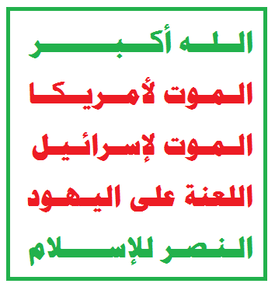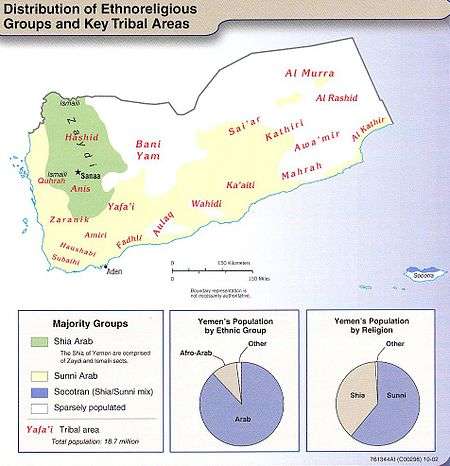Houthis
| Houthis الحوثيون | |
|---|---|
| Participant in Houthi insurgency in Yemen, the Yemeni Revolution, and the Yemeni Civil War | |
|
| |
| Active |
1994–present (armed since 2004) |
| Ideology |
Zaydi Revivalism[1] Anti-imperialism[2][3][4] Anti-Zionism[4] Antisemitism[5] |
| Groups | Houthis, allied Zaidi tribes in Sa'dah |
| Leaders | |
| Headquarters | Sa'dah, Yemen |
| Area of operations | |
| Strength | 259,000 (2011)[6][7] |
| Allies |
State allies Non-state allies |
| Opponents |
State opponents Other state opponents
Non-state opponents |
| Battles and wars |
|
The Houthis (Arabic: الحوثيون al-Ḥūthiyyūn IPA: [ħuːθijuːn]), officially called Ansar Allah (anṣār allāh أنصار الله "Supporters of God"), is a Zaidi Shia-led religious-political movement that emerged from Sa'dah, northern Yemen in the 1990s and has fought against the government of the ousted president Ali Abdullah Saleh on and off since 2004. In late 2014, Houthis fixed their relationship with the ousted president Ali Abdullah Saleh, and with his help, Houthis took control of the capital and much of the north.[21]
Like many of Iranian-backed military militia such as Hezbollah, the Houthi movement attracts its Zaidi-Shia followers in Yemen by promoting regional political-religious issues in its media, including the overarching US-Israeli conspiracy and Arab "collusion".[22][23] In 2003, the Houthi's slogan "God is great, death to the US, death to Israel, curse the Jews, and victory for Islam", became the group's trademark.[23] Beside, the movement claims that it has some local-political agenda such as ending the economic under-development, political marginalization in Yemen, as well as seeking autonomy in only the areas where they are predominant not all of Yemen.[24] Tension between the Houthis and the central government steadily grew in the 1990s, with war breaking out in 2004 with the group's founder, Hussein Badreddin al-Houthi,[25] leading a rebellion against then President Ali Abdullah Saleh. The group is now led by Abdul-Malik al-Houthi, brother of the first leader, who was reportedly killed by Saleh's Yemeni army forces in 2004.[26][27]
The Houthis had some role in the 2011 Yemeni Revolution, participating in the street protests and coordinating with other opposition groups. Houthis also had joined National Dialogue Conference in Yemen which is part of the Gulf Cooperation Council Initiative. However, after they took over the government with the help from the former president Ali Abdullah Saleh, they announced their rejection of the provisions of the November 2011 Gulf Cooperation Council deal, claiming that it did not fundamentally reform governance and describe it as "a conspiracy" against them. In addition, they have also some other claims such as that it will transform the country into a federation of six regions, arguing that "it divided Yemen into poor and wealthy regions" and saw it as a blatant attempt to weaken them by dividing areas under their control between separate regions.[24]
In 2014–2015 Houthis took over the government in Sana'a with the help of the former president Ali Abdullah Saleh, and announced the fall of the current government of Abd Rabbuh Mansur Hadi.[28] Houthis have gained control of most of the north part of Yemen's territory and are currently resisting the Saudi-led military intervention in Yemen that claims seeking to restore the internationaly-recognized Yemeni government[29] to the power. Houthis, Saleh forces, Yemen’s government, and the forces of Saudi Arabian-led coalition, have been attacked by the Islamic State militant group.[30][31]
History

The Houthis belong to the Shia tribesmen of North Yemen who are renowned among Yemeni tribes for their ruggedness, sharpshooting abilities, honour, and bravery in combat. This is while they are also disregarded as being ignorant or backward, by more metropolitan Yemenis, such as Sana'anis or Adenites. They have been known for being very moderate and are the closest to Sunni Islam of all the Shi'a sects.[32]
According to Ahmed Addaghashi, a professor at Sanaa University, the Houthis began as a moderate theological movement that preached tolerance and held a broad-minded view of Yemeni people.[33] Their first organization, "the Believing Youth" (BY), was founded in 1992 in Saada Governorate[32]:1008 by either Mohammed al-Houthi,[34]:98 or his brother Hussein al-Houthi.[35]
The Believing Youth established school clubs and summer camps[34]:98 in order to "promote a Zaidi revival" in Saada.[35] By 1994–1995, 15–20,000 students had attended BY summer camps. The religious material included lectures by Mohammed Hussein Fadhlallah (a Lebanese Shiite scholar) and Hassan Nasrallah (Secretary General of Lebanon's Hezbollah Party) "[34]:99[36]
The formation of the Houthi organisations have been described by Adam Baron of the European Council on Foreign Relations as a reaction to foreign intervention: shoring up Zaidi support against the perceived threat of Saudi-influenced ideologies in Yemen and a general condemnation of the former Yemeni government’s alliance with the United States, which, along with complaints regarding the government’s corruption and the marginalisation of much of the Houthis’ home areas in Saada constituted the group’s key grievances.[37]
Although Hussein al-Houthi, who was killed in 2004, had no official relation with Believing Youth, according to Zaid, he contributed to the radicalisation of some Zaydis after the 2003 invasion of Iraq. BY-affiliated youth adopted anti-American and anti-Jewish slogans which they chanted in the Saleh Mosque in Sana'a after Friday prayers. According to Zaid, the followers of Houthi's insistence on chanting the slogans attracted the authorities' attention, further increasing government worries over the extent of the al-Houthi movement’s influence. "The security authorities thought that if today the Houthis chanted `Death to America’, tomorrow they could be chanting `Death to the president [of Yemen]". 800 BY supporters were arrested in Sana'a in 2004. President Ali Abdullah Saleh then invited Hussein al-Houthi to a meeting in Sana'a, but Hussein declined. On 18 June 2004 Saleh sent government forces to arrest Hussein.[38] Hussein responded by launching an insurgency against the government but was killed on 10 September 2004.[39] The insurgency continued intermittently until a ceasefire agreement was reached in 2010.[33]
The Houthis participated in the 2011 Yemeni Revolution, as well as the ensuing National Dialogue Conference (NDC).[40] However, they rejected the provisions of the November 2011 Gulf Cooperation Council deal on the ground that "it divide[d] Yemen into poor and wealthy regions" and also in response to assassination of their representative at NDC.[41][42]
As the revolution went on, Houthis gained control of greater territory. By 9 November 2011, Houthis were said to be in control of two Yemeni governorates (Saada and Al Jawf) and close to taking over their third governorate (Hajjah),[43] which would enable them to launch a direct assault on Yemeni capital Sana'a.[44] In May 2012, it was reported that the Houthis controlled a majority of Saada, Al Jawf, and Hajjah governorates; they had also gained access to the Red Sea and started erecting barricades north of the capital Sana'a in preparation for more conflict.[45]
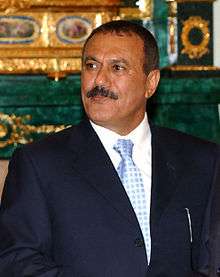
By 21 September 2014, Houthis were said to control parts of the Yemeni capital, Sana'a, including government buildings and a radio station.[46] While control of the capital expanded to the rest of Sana'a, as well as other towns such as Rada', control was strongly challenged by Al-Qaeda. It was believed by the Gulf States that the Houthis had accepted aid from Iran while Saudi Arabia was aiding their Yemeni rivals.[47]
On 20 January 2015, Houthi rebels seized the presidential palace in the capital. President Abd Rabbuh Mansur Hadi was in the presidential palace during the takeover but was not harmed.[48] The movement officially took control of the Yemeni government on 6 February, dissolving parliament and declaring its Revolutionary Committee to be the acting authority in Yemen.[28] On 20 March 2015, The al-Badr and al-Hashoosh mosques came under suicide attack during midday prayers. The Islamic State of Iraq and the Levant quickly claimed responsibility. The blasts killed 142 Houthi worshippers and wounded more than 351, making it the deadliest terrorist attack in Yemen's history.[49]
In a televised speech on 22 March, Houthi leader Abdul Malik al-Houthi accused the US and Israel of supporting the terrorists attacks. He blamed regional Arab states for financing terrorist groups operating inside Yemen.[50] On 27 March 2015, in response to perceived Houthi threats to Sunni factions in the region, Saudi Arabia along with Bahrain, Qatar, Kuwait, UAE, Egypt, Jordan, Morocco, and Sudan led a gulf coalition airstrike in Yemen.[51] The military coalition includes the United States which is helping with the planning of air strikes, as well as logistical and intelligence support.[52]
According to a 2015 September report by Esquire magazine, the Houthis, once the outliers, are now one of the most stable and organised social and political movements in Yemen. The power vacuum created by Yemen’s uncertain transitional period has drawn more supporters to the Houthis. Many of the formerly powerful parties, now disorganised with an unclear vision, have fallen out of favour with the public, making the Houthis — under their newly branded Ansar Allah name — all the more attractive.[4]
Membership and support
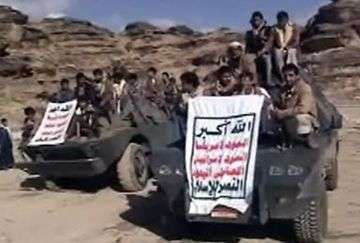
There is a difference between the al-Houthi family, which has about 20 members[34]:102 and the Houthi movement, which took the name "Houthi" after the death of Hussein Badreddin al-Houthi in 2004.
The Houthis avoid assuming a singular tribal identity. Instead, the group strategically draws support from tribes of the northern Bakil federation, rival to the Hashid federation which had been a traditional ally of the ousted central government. The Houthis’ lack of centralised command structure allows them to generate immense support, as Yemenis from diverse backgrounds have joined their cause.[53]
Membership of the group had between 1,000 and 3,000 fighters as of 2005[54] and between 2,000 and 10,000 fighters as of 2009.[55] In 2010, the Yemen Post claimed that they had over 100,000 fighters.[56] According to Houthi expert Ahmed Al-Bahri the Houthis had a total of 100,000-120,000 followers, including both armed fighters and unarmed loyalists.[57]
As of 2015, the group is reported to have managed to pick up swaths of new supporters outside their traditional demographics.[37] [58] On 5 February 2016, Iranian TV named PressTV reported that Men of Hamdan, one of Yemen's most powerful tribes, rallied to the north of the capital, Sana'a, vowing to provide support in the form of potential mobilisation for the country's fighters resisting the current elected Yemeni government. In a gathering held in the capital, hundreds of tribesmen from the southern parts pledged union against what they described as a U.S.-Israeli initiative targeting the country, which was being implemented by Saudi Arabia.[59]
Ideology
Houthis belong to the Zaidi branch of Islam, also known as Fivers, a sect of Islam almost exclusively present in Yemen.[60]
Zaydis make up about 45 percent of the population, Sunnis make up 53 percent, and there are also tiny minorities of Muslims who are members of other Shia sects — the Ismaili and Twelver communities. Al-Houthi Zaydis are estimated to make up about 30 percent of the population, according to Hassan Zaid, secretary-general of the al-Haq opposition party. The Zaydis ruled Yemen for 1,000 years up until 1962. During this time they ferociously defended their independence and fought off foreign powers (Egypt, the Ottomans) who controlled lower Yemen and tried to extend their rule to the north.[38]
Similar to Shia Muslims in matters of religious law and rulings, the Houthi belief in the concept of an Imamate as being essential to their religion makes them distinct from Sunnis.[61] As of 2014 it has been observed that "The Houthi group's approach is in many ways similar to that of Hizbollah in Lebanon. Similarly religiously based and Iran-backed, both groups follow the same military doctrine and glorify the Khomeini revolution in Iran".[62]
As a consequence, the Houthis have regularly been accused, even by many fellow Zaidis, of secretly being converts or followers of the Twelver sect, which is the official religion of their ally and backer Iran.[60][63][64][65]
The Houthis have asserted that their actions are to fight against the expansion of Salafism in Yemen,[63] and for the defence of their community from discrimination, whereas the Yemeni government has in turn accused the insurgents of intending to overthrow the regime out of a desire to institute Zaidi religious law,[67] destabilising the government and stirring anti-American sentiment.[68][69] The Yemeni government has also accused the Houthis of having ties to external backers, in particular the Iranian government.[70] In turn, the Houthis have countered with allegations that the Yemeni government is being backed by al-Qaeda and Saudi Arabia,[71][72][73] The discord has led some publishers to fear that further confrontations may lead to an all-out Sunni-Shiite war.[74]
Flag and slogan
The group's flag reads as following: "God Is Great, Death to America, Death to Israel, Curse on the Jews, Victory to Islam".[75] This motto is partially modelled on the motto of revolutionary Iran, which reads "Death to U.S. and death to Israel".[76]
Some Houthi supporters stress that their ire for the U.S. and Israel is directed toward the governments of America and Israel. Ali al-Bukhayti, the spokesperson and official media face of the Houthis, tried to reject the literal interpretation of the slogan by stating that in one of his interview "We do not really want death to anyone. The slogan is simply against the interference of those governments [i.e. U.S. and Israel]".[77] However, in the Arabic Houthi-affiliated TV and radio stations they use religious connotations associated with jihad against Israel and the US. They also call Saudi Arabia a U.S. puppet state.[23]
Charges of harassment against Jews
The Houthis have been accused of expelling or restricting some members of the ancient and impoverished rural Jews of Yemen. There have been also reports about supporters of the Houthis bullying or attacking the members of the Yemeni Jewish community.[78][79] Houthi officials, however, have denied any involvement in the harassment, asserting that under Houthi control Jews in Yemen would be able to live and operate freely as any other Yemeni citizen. "Our problems are with Zionism and the occupation of Palestine, but Jews here have nothing to fear," said Fadl Abu Taleb, a spokesman for the Houthis. But despite insistence by Houthi leaders that the movement is not sectarian, a Yemeni Jewish rabbi has reportedly said that many Jews remain terrified by the movement’s slogan.[79] As a result, Yemeni Jews reportedly retain a negative sentiment towards the Houthis, who committed persecutions against them.[5] According to Ayoub Kara, Houthi militants had given an ultimatum telling Jews to "convert to Islam or leave Yemen".[80]
Leaders
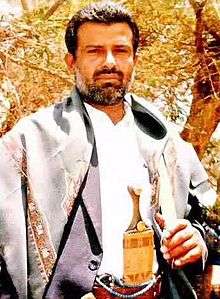
- Hussein Badreddin al-Houthi – former leader (killed 2004)
- Abdul-Malik Badreddin al-Houthi – leader
- Yahia Badreddin al-Houthi – senior leader
- Abdul-Karim Badreddin al-Houthi – high-ranking commander
- Badr Eddin al-Houthi – spiritual leader (died 2010)
- Abdullah al-Ruzami – former military commander
- Abu Ali Abdullah al-Hakem al-Houthi – military commander
- Saleh Habra – political leader[81]
- Fares Mana'a – Houthi-appointed governor of Sa'dah[82] and former head of Saleh's Presidential committee[83]
Motives and objectives
When armed conflict for the first time erupted back in 2004 between the Yemeni government and Houthis, the then-Yemeni President accused Houthis and other Islamic opposition parties of trying to overthrow the government and the republican system. However Houthi leaders for their part rejected the accusation by saying that they had never rejected the president or the republican system but were only defending themselves against government attacks on their community.[84] Zaidi Shi'ites compose one-third of the population of Yemen and Houthis have often voiced the grievances of the Zaidi population.[8]
The group has also exploited the popular discontent over corruption and reduction of government subsidies.[8] According to a February 2015 Newsweek report, Houthis are fighting "for things that all Yemenis crave: government accountability, the end to corruption, regular utilities, fair fuel prices, job opportunities for ordinary Yemenis and the end of Western influence".[85]
Hassan al-Homran, a former spokesperson for Ansar Allah, has said that "Ansar Allah supports the establishment of a civil state in Yemen. We want to build a striving modern democracy. Our goals are to fulfil our people's democratic aspirations in keeping with the Arab Spring movement."[86] In an interview with Yemen Times, Hussein al-Bukhari, a Houthi insider, said that Houthis' preferable political system is a republic with elections where women can also hold political positions, and that they do not seek to form a cleric-led government after the model of Islamic Republic of Iran for "we cannot apply this system in Yemen because the followers of the Shafi (Sunni) doctrine are bigger in number than the Zaydis."[87]
Ali Akbar Velayati, International Affairs Advisor to Supreme Iranian Leader Ayatollah Seyyed Ali Khamenei, stated in October 2014 that "We are hopeful that Ansar-Allah has the same role in Yemen as Hezbollah has in eradicating the terrorists in Lebanon".[88]
Activism and tactics
Political
During their campaigns against the ousted Hadi government, Houthis used civil disobedience. Following the Yemeni government's decision in 13 July 2014 to increase fuel prices,[89] Houthi leaders succeeded in organising massive rallies in the capital Sana'a to protest the decision and to demand resignation of the incumbent government of Abd Rabbuh Mansur Hadi for "state-corruption".[90] These protests developed into the 2014-2015 phase of the insurgency. Similarly, following 2015 Saudi-led airstrikes against Houthis which claimed civilians lives, Yemenis responded to the Abdul-Malik al-Houthi's call and took to streets of the capital, Sana'a, in tens of thousands to voice their anger at the Saudi invasion.[91][92]
Cultural
The Houthis have also held a number of mass gatherings since the revolution. On 24 January 2013, thousands gathered in Dahiyan, Sa'dah and Heziez, just outside Sana'a, to celebrate Mawlid al-Nabi, the birth of Mohammed. A similar event took place on 13 January 2014, but this time at the main sports stadium in Sana'a. On this occasion, men and women were completely segregated: men filled the open-air stadium and football field in the centre, guided by appointed Houthi safety officials wearing bright vests and matching hats; women poured into the adjacent indoor stadium, led inside by security women distinguishable only by their purple sashes and matching hats. The indoor stadium held at least five thousand women — ten times as many attendees as the 2013 gathering.[4]
Combat and military
In 2009, US Embassy sources have reported that Houthis used increasingly more sophisticated tactics and strategies in their conflict with the government as they gained more experience, and that they fought with religious fervor and courage.[93][94]
Armed strength
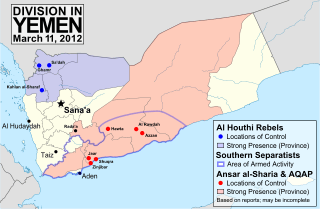
Saudi and former Yemeni officials have claimed that the Houthis have received significant support from Iran in the form of weapons, money and training since 2004, while Houthi leadership denies having received weapons or financial support from Iran.[8][95] Also, Tehran denied the allegation of Houthis arm support by Iran.[96] A December 2009 cable between Sanaa and various intelligence agencies disseminated by WikiLeaks states that US State Dept. analysts believed the Houthis obtained weapons from the Yemeni black market and corrupt members of the Republican Guard.[93] On the edition of 8 April 2015 of PBS Newshour, Secretary of State John Kerry stated that the US knew Iran was providing military support to the Houthi rebels in Yemen, adding that Washington "is not going to stand by while the region is destabilised".[97]
Despite being less in numbers and equipment than the Saudi-led coalition, Ansar Allah managed to inflict heavy losses and destroy dozens of invading vehicles in the city of Ma'rib on 14 September 2015.[98] In addition, Ansar Allah managed to capture a Saudi soldier, Ibrahim Araj Mohammad Hakami whose confession was broadcast on Ansar Allah news channel Al-Masirah TV.[99][100][101] Recently on late 2015, Houthis announced the local production of short range ballistic missile Qaher-1 on Al-Masirah TV.[102]
Allegations of Iran's support
Phillip Smyth of the Washington Institute on Near East Policy told Business Insider that Iran views Shia groups in the Middle East as "integral elements to the Islamic Revolutionary Guard Corps (IRGC)." Smyth confirmed to Business Insider the strong bond between Iran and the Houthi uprising working to overthrow the government in Yemen. According to Smyth, in many cases Houthi leaders go to Iran for ideological and religious education, and Iranian and Hezbollah leaders have been spotted on the ground advising the Houthi troops.These Iranian advisers are likely responsible for training the Houthis to use the type of sophisticated guided missiles fired at the US Navy.[103] For Iran, supporting the revolt in Yemen is "a good way to bleed the Saudis," Iran's regional and ideological rival. Essentially, Iran is backing the Houthis to fight against a Saudi-led coalition of Gulf States fighting to maintain government control of Yemen.[104]
In 2013, photographs released by the Yemeni government show the United States Navy and Yemen’s security forces seized a class of shoulderfired antiaircraft missiles not publicly known to have been out of state control.[105]
According to Saudi-owned Al Arabiya, Fars News Agency, which is the official news agency of the Iran’s Revolutionary Guards, has admitted to arming Houthis with missiles and training. The agency quoted “a prominent analyst” Seyed Sadeq al-Sharafi as saying that militias “are developing their missile power to target Riyadh and Dubai in the future, after they increased their missile and military capabilities and expanded the range of their military operations against the enemies"[106]
In April 2016, the Pentagon announced that the U.S. Navy ship stopped a massive Iranian arms shipment dead in its tracks, seizing thousands of weapons, AK-47 rifles and rocket-propelled grenade launchers that likely were headed to Yemen.[107]
Also, the ousted president Ali Abdullah Saleh, who has been in conflicts with them for 2 decades and currently allied with them, has accused Iran of supporting the Houthi many times. Saleh stated in a New York Times' interview that "The real reason they received unofficial support from Iran was because they repeat same slogan that is raised by Iran death to America, death to Israel". He also said "The Iranian media repeats statements of support for these Houthi elements. They are all trying to take revenge against the USA on Yemeni territories".[22]
Allegations of human rights violations
Houthis have been accused of violations of international humanitarian law such as using child soldiers,[108][109][110] shelling civilian areas,[111] forced evacuations, executions and human shielding.[93][112] According to the Human Right Watch, Houthis have inclined up their recruitment of children in 2015. The UNICEF mentioned that children with the Houthis and other armed groups in Yemen comprise up to a third of all fighters in Yemen.[113] Human Rights Watch has further accused Houthi forces of using landmines in Yemen’s third-largest city of Taizz which has caused many civilian casualties and prevent the return of families displaced by the fighting.[114] HRW has also accused the Houthis of interfering with the work of Yemen’s human rights advocates and organizations.[115]
Governance
According to the 2009 US Embassy cable leaked by WikiLeaks, Houthis have reportedly established courts and prisons in areas they control. They impose their own laws on local residents, demand protection money, and dispense rough justice by ordering executions. AP's reporter, Ahmad al-Haj argued that the Houthis were winning hearts and minds by providing security in areas long neglected by the Yemeni government (currently ousted) while limiting the arbitrary and abusive power of influential sheikhs. According to the Civic Democratic Foundation, Houthis help resolve conflicts between tribes and reduce the number of revenge killings in areas they control. The US ambassador believed that the reports that explain Houthi role as arbitrating local disputes were more likely than the sinister suggestions.[93][94]
Areas under administration
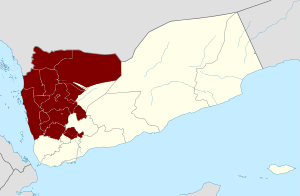
The Houthis exert de facto authority over the bulk of North Yemen. North Yemen was united with South Yemen in 1990; the Yemen government has repeatedly suppressed separatist protests by force.[116] The Houthis' direct administration includes the following territories:
- All of Saada Governorate[82]
- All of 'Amran Governorate[117]
- Majority of Al Jawf Governorate,[118] including:
- All of Hajjah Governorate[123]
- Majority of Sana'a Governorate including strong presence in:
- Arhab District (partial control)[124]
- All of Dhamar Governorate[125]
- All of Al Mahwit Governorate[126]
- All of Raymah Governorate[127]
References
- ↑ "What is the Houthi Movement?". Tony Blair Faith Foundation. 25 September 2014. Archived from the original on 6 October 2014.
- ↑ "Houthis are fighting "Western Imperialism"". PressTV.
- ↑ "Will Yemen kick off the War of the two Blocks?'". Russia Today.
- 1 2 3 4 Plotter, Alex (4 June 2015). "Yemen in crisis". Esquire. Retrieved 5 September 2015.
- 1 2 "Persecution Defines Life for Yemen's Remaining Jews". New York Times. 19 February 2015.
- ↑ CNN Medics: Militants raid Yemen town, killing dozens, 27 November 2011.
- ↑ Houthis Kill 24 in North Yemen, 27 November 2011.
- 1 2 3 4 5 "Iranian support seen crucial for Yemen's Houthis". Reuters. 15 December 2014. Retrieved 31 March 2015.
- ↑ "Syrian regime coordinates military training with Yemeni Houthis". ARA News. 9 March 2015. Retrieved 9 March 2015.
- ↑ "North Korea's Balancing Act in the Persian Gulf". The Huffington Post. 17 August 2015. Retrieved 17 August 2015.
North Korea's military support for Houthi rebels in Yemen is the latest manifestation of its support for anti-American forces.
- ↑ "Putin's Latest Moves: The Military Alliance Among Iran, Hezbollah And Russia In Syria Could Spread To Yemen". International Business Times. 25 September 2015. Retrieved 25 September 2015.
Moscow is now supporting the Tehran-backed Houthi rebels who are fighting forces loyal to the U.S.-supported exiled president.
- ↑ "Source: Hezbollah, Iran helping Hawthi rebels boost control of Yemen's capital". Haaretz. 27 September 2014. Retrieved 31 March 2015.
- ↑ Rafi, Salman (2 October 2015). "How Saudi Arabia's aggressive foreign policy is playing against itself". Asia Times. Retrieved 23 January 2016.
- 1 2 3 4 5 6 7 8 9 "Egypt, Jordan, Sudan and Pakistan ready for ground offensive in Yemen: report". the globe and mail. 26 March 2015. Retrieved 26 March 2015.
- ↑ "Saudi Arabia launches airstrikes in Yemen". CNN. 26 March 2015. Retrieved 25 March 2015.
- ↑ "SOMALIA: Somalia finally pledges support to Saudi-led coalition in Yemen – Raxanreeb Online". RBC Radio. 7 April 2015. Retrieved 7 April 2015.
- ↑ "Al-Qaeda Announces Holy War against Houthis- Yemen Post English Newspaper Online". yemenpost.net.
- ↑ "Islamic State leader urges attacks in Saudi Arabia: speech". Reuters. Retrieved 26 February 2015.
- ↑ "Around 400 Blackwater Mercenaries Fighting for Saudi-Led Coalition alliance".
- ↑ "Australian mercenary reportedly killed in Yemen clashes".
- ↑ HRW. "Yemen". HRW. Retrieved 15 October 2016.
- 1 2 "An Interview With President Ali Abdullah Saleh". NyTimes. Retrieved 15 October 2016.
- 1 2 3 "Houthi propaganda: following in Hizballah's footsteps". alaraby. alaraby. Retrieved 15 October 2016.
- 1 2 JUNEAU, THOMAS (May 2016). "Iran's policy towards the Houthis in Yemen: a limited return on a modest investment". International Affairs. 92 (3): 647–663. doi:10.1111/1468-2346.12599.
- ↑ "5 Things to Know About the Houthis of Yemen". 12 February 2015.
- ↑ Deaths in Yemeni mosque blast. Al Jazeera, 2 May 2008.
- ↑ Press TV Saudi soldier, Houthi leaders killed in north Yemen, 19 November 2009.
- 1 2 "Yemen's Houthis form own government in Sanaa". Al Jazeera. 6 February 2015. Retrieved 7 February 2015.
- ↑ "International Support to Yemen's Legitimate Government". aawsat. Retrieved 15 October 2016.
- ↑ "Yemen govt vows to stay in Aden despite IS bombings". Yahoo News. 7 October 2015.
- ↑ Agence France-Presse (7 October 2015). "Arab Coalition Faces New Islamic State Foe in Yemen Conflict". NDTV.com.
- 1 2 Freeman, Jack (2009). "The al Houthi Insurgency in the North of Yemen: An Analysis of the Shabab al Moumineen". Studies in Conflict & Terrorism. 32 (11): 1008–1019. doi:10.1080/10576100903262716. ISSN 1057-610X.
- 1 2 Al Batati, Saeed (21 August 2014). "Who are the Houthis in Yemen?". Al Jazeera. Archived from the original on 23 August 2014.
- 1 2 3 4 "Regime and Periphery in Northern Yemen: The Huthi Phenomenon" (PDF). RAND. 2010. Retrieved 23 January 2013.
- 1 2 "Yemen's Abd-al-Malik al-Houthi". BBC. 3 October 2014. Retrieved 29 November 2014.
- ↑ "Profile: The crisis in Yemen". thenational.scot.
- 1 2 Adam Baron (25 March 2015). "What Went Wrong with Yemen". Retrieved 18 September 2015.
- 1 2 "Yemen: The conflict in Saada Governorate - analysis". IRIN. 24 July 2008. Retrieved 29 November 2014.
- ↑ "Yemeni forces kill rebel cleric". BBC News. 10 September 2004. Archived from the original on 21 November 2006.
- ↑ "The Huthis: From Saada to Sanaa". Middle East Report N°154. International Crisis Group. 10 June 2014. Archived from the original on 8 April 2015.
- ↑ "Yemen Al Houthi rebels slam federation plan as unfair". Gulf News. 11 February 2014. Retrieved 16 March 2014.
- ↑ al-Hassani, Mohammed (6 February 2014). "HOUTHI SPOKESPERSON TALKS TO THE YEMEN TIMES". Yemen Times. Retrieved 16 March 2014.
- ↑ "Houthis Close to Control Hajjah Governorate, Amid Expectations of Expansion of Control over Large Parts of Northern Yemen". Islam Times. 29 November 2011. Archived from the original on 5 April 2012.
- ↑ "Al-Houthi Expansion Plan in Yemen Revealed". Yemen Post. 9 November 2011. Archived from the original on 9 November 2011.
- ↑ "New war with al-Houthis is looming". Yemen observer. Retrieved 23 January 2013.
- ↑ "Houthis seize government buildings in Sanaa". Al Jazeera. Retrieved 21 September 2014.
- ↑ Kareem Fahim (7 January 2015). "Violence Grows in Yemen as Al Qaeda Tries to Fight Its Way Back". The New York Times. The Times Company. Retrieved 8 January 2015.
- ↑ "Yemen Houthi rebels 'seize presidential palace'". BBC News. 20 January 2015.
- ↑ "Death toll hits 142 from attacks in Yemen mosques". Al Bawaba. 20 March 2015. Archived from the original on 22 March 2015.
- ↑ "US, Israel behind Yemen terrorist attacks: Houthi leader". Press TV. 22 March 2015. Archived from the original on 3 April 2015.
- ↑ "Saudi 'Decisive Storm' waged to save Yemen". Al Arabiya News. 26 March 2015. Archived from the original on 2 April 2015.archive does not retrieve properly, as of 3 April 2015
- ↑ Keane, Angela Greiling (26 March 2015). "U.S. Backs Saudi-Led Yemeni Bombing With Logistics, Spying". Bloomberg News. Archived from the original on 3 April 2015.
- ↑ "Hothi / Houthi / Huthi; Ansar Allah; al-Shabab al-Mum'en / Shabab al-Moumineen (Believing Youth)". globalsecurity.org.
- ↑ Philips, Sarah (28 July 2005). Cracks in the Yemeni System. Middle East Report Online.
- ↑ "Pity those caught in the middle". The Economist. 19 November 2009.
- ↑ Almasmari, Hakim (10 April 2010). "Editorial: Thousands Expected to die in 2010 in Fight against Al-Qaeda". Yemen Post. Archived from the original on 3 March 2011.
- ↑ Ahmed Al-Bahri: Expert in Houthi Affairs, 10 April 2010.
- ↑ HRW. HRW https://www.hrw.org/news/2015/05/12/yemen-houthis-send-children-battle. Retrieved 15 October 2016. Missing or empty
|title=(help) - ↑ "Yemeni tribes call for mobilization against Saudi Arabia". PressTV.
- 1 2 Al-Shamahi, Abubakr (7 February 2014). "Yemen is more nuanced than 'Sunni' & 'Shia'". Yemen Times. Archived from the original on 2 January 2015.
- ↑ Pike, John. "Zaydi Islam". Retrieved 2 September 2014.
- ↑ "Houthis seek to impose a new reality on Yemen". The National. 23 September 2014. Retrieved 31 March 2015.
- 1 2 Manuel Almeida (8 October 2014). "Profile: Who are Yemen's Houthis?". Al Arabiya News. Retrieved 2 February 2015.
- ↑ "Hothi/Houthi/Huthi: al-Shabab al-Mum'en/Shabab al-Moumineen (Believing Youth)". GlobalSecurity. Retrieved 2 February 2015.
- ↑ Bengio, Ofra; Litvak, Meir, eds. (8 November 2011). The Sunna and Shi'a in History: Division and Ecumenism in the Muslim Middle East. Palgrave Macmillan. p. 244. ISBN 9780230370739.
- ↑ M. Izady. "Yemen:Ethno-Religious Composition" Columbia University. 2014. Accessed 12 April 2015
- ↑ "Deadly blast strikes Yemen mosque". BBC News. 2 May 2008. Retrieved 11 November 2009.
- ↑ Sultan, Nabil (10 July 2004).
- ↑ http://www.atimes.com/atimes/Middle_East/FG10Ak02.html Rebels have Yemen on the hop
- ↑ "Cable Viewer". Wikileaks. 17 February 2010. Retrieved 23 January 2013.
- ↑ "Saudi, al-Qaeda support Yemen crackdown on Shias". Press TV. 29 August 2009. Retrieved 1 February 2010.
- ↑ "Al-Qaeda Fighting for Yemeni Government Against Houthi Shia Rebels...". 29 December 2009. Retrieved 1 February 2010.
- ↑ "Yemen employs al-Qaeda mercenaries: Houthis". Press TV. 28 October 2009. Retrieved 1 February 2010.
- ↑ The Arab Revolts, 2013 David Mcmurray
- ↑ Arabic: الله أكبر، الموت لأمريكا، الموت لإسرائيل، اللعنة على اليهود، النصر للإسلام; Transliterated as "alllah 'akbara, almawt li'amrika, almawt li'iisrayiyla, alllaenat ealaa alyahud, alnnasr lil'iislam"
- ↑ ShahidSaless, Shahir (30 March 2015). "Does Iran really control Yemen". Al Monitor. Archived from the original on 13 February 2015.
- ↑ "Photo Essay: Rise of the Houthis". Newsweek. 9 February 2015. Retrieved 27 March 2015.
- ↑ "Amid persecution, Yemeni Jews face extinction".
- 1 2 ""Damn the Jews" proving more than just a slogan". Yemen Times.
- ↑ Houthis militants to Jews: Convert or leave Yemen. 11 October 2015. Yemen Online. Retrieved 8 February 2016.
- ↑ "Meetings push government and Houthis closer towards "reconciliation"". Yemen Times. 29 March 2012. Retrieved 23 January 2013.
- 1 2 Al-Batati, Saeed (28 March 2011). "Yemeni regime loses grip on four provinces". Arab News. Archived from the original on 31 March 2011.
- ↑ "Sana'a Cards to Pressurize Houthis to Enter New Dialogue Rounds". Yemen Post. Archived from the original on 1 May 2012.
- ↑ Arrabyee, Nasser (25 May 2005). "Rebellion continues". Al-Ahram Weekly. Retrieved 11 April 2007.
- ↑ "Photo Essay: The Rise of the Houthis". Newsweek. 9 February 2015. Retrieved 17 February 2015.
- ↑ "Hassan al-Homran, spokesperson for Ansar Allah". Yemen Post. 22 November 2013.
- ↑ "Al-Bukhari to the Yemen Times: "The Houthis' takeover can not be called an invasion"". Yemen Times. 21 October 2014. Retrieved 17 February 2015.
- ↑ "Analysis: Iranian Reactions to Operation Decisive Storm". The Long War Journal. 31 March 2015. Retrieved 31 March 2015.
- ↑ "Yemenis protest fuel price hikes in several cities". Press TV. Archived from the original on 11 September 2014.
- ↑ "1000s of Yemen's Houthis protest in Sana'a". Press TV. 20 August 2014. Archived from the original on 24 August 2014.
- ↑ "Supporters of Houthi revolutionaries take to streets in capital, Sana'a". Press TV. 26 March 2015. Archived from the original on 1 April 2015.
- ↑ "Coalition jets continue to hit Houthi targets in Yemen". Al Jazeera. 27 March 2015. Archived from the original on 2 April 2015.
- 1 2 3 4 "Cable:09SANAA2186_a". Wikileaks. 9 December 2009. Retrieved 2 April 2015.
- 1 2 "Cablegate: Who Are the Houthis, Part Two: How Are They". Scoop (website).
- ↑ "Iranian ship unloads 185 tons of weapons for Houthis at Saleef port". Al Arabiya News. 20 March 2015. Archived from the original on 24 March 2015.
- ↑ Tisdall, Simon (26 March 2015). "Iran-Saudi proxy war in Yemen explodes into region-wide crisis". The guardian. Retrieved 5 June 2015.
- ↑ "Kerry Says U.S. Knew of Iran's Military Aid to Houthi Rebels". The New York Times. 10 April 2015.
- ↑ "Yemeni Army, Popular Committees Inflict Heavy Losses upon Saudi-led Invaders". www.manartv.com.lb. Retrieved 17 September 2015.
- ↑ "Yemen: Houthi Rebels Captured 'a Number of Saudi Soldiers'?". Retrieved 17 September 2015.
- ↑ "Yemen rebels claim capture of Saudi troops, show one on TV". Retrieved 17 September 2015.
- ↑ "فيديو لـ"المتحدث باسم أسرى الجيش السعودي"". الأخبار. Retrieved 17 September 2015.
- ↑ "(فيديو+صور) "قاهر1" أول صاروخ بالستي معدل محلياً يضرب قاعدة خميس مشيط | المسيرة نت - قناة المسيرة الفضائية". Retrieved 2016-03-10.
- ↑ cf. "US general suspects Iran role in Houthi attacks on US ships". The Times of Israel. 2016-10-20. Retrieved 2016-10-25.
- ↑ businessinsider. Why the US confronted Iranian-backed militants in Yemen, and the risks that lie ahead.
- ↑ "Seizure of Antiaircraft Missiles in Yemen Raises Fears That Iran Is Arming Rebels There". nytimes. nytimes. Retrieved 15 October 2016.
- ↑ alarabiya. "Iran admits to arming Houthis with missiles". alarabiya. alarabiya.
- ↑ "US seizes thousands of Iranian weapons, including grenade launchers, in Arabian Sea". fox news. Retrieved 15 October 2016.
- ↑ http://english.al-akhbar.com/node/912
- ↑ "Checkpoint children: Armed Houthis under 18". Yemen Times.
- ↑ "Q & A on The Conflict in Yemen and International Law - Human Rights Watch". hrw.org.
- ↑ Al-Haj, Ahmed; Youssef, Nour. "Death toll from Yemen rebel shelling doubles to nearly 100". Yahoo! News. Retrieved 21 July 2015.
- ↑ http://english.alarabiya.net/en/webtv/news-bulletin/2015/03/31/1900GMT.html
- ↑ HRW. "Yemen: Houthis Send Children Into Battle". HRW. HRW.
- ↑ HRW. "Yemen: Houthi Landmines Claim Civilian Victims". HRW. HRW. Retrieved 14 October 2016.
- ↑ HRW. "Yemen: Houthis Ban Rights Advocate's Travel". HRW. HRW. Retrieved 14 October 2016.
- ↑ AlAhmad, Safa (16 March 2015). "Meeting the Houthis - and their enemies". BBC News Magazine. Archived from the original on 3 April 2015.
- ↑ Heinze, Marie-Christine. "The primacy of stability over real change". Dialogue with the Islamic World. Qantara.de (Bundeszentrale für politische Bildung). Retrieved 26 February 2015.
- ↑ Hakim Almasmari, For CNN (27 November 2011). "Medics: Militants raid Yemen town, killing dozens". CNN. Archived from the original on 1 December 2011.
- ↑ "Suicide bombing kills 14 Houthis in Al-Jawf". Yemen Times. 28 May 2012. Retrieved 26 February 2015.
- 1 2 3 "Houthi Group Builds Checkpoints after Deadly Car Bomb Blast". Yemen Post. Archived from the original on 3 December 2010.
- ↑ "Picking up the pieces". Al Ahram Weekly. 17 November 2011. Archived from the original on 3 April 2015.
- ↑ "24 Houthis Killed in Car Bomb Blast in Jawf". Yemen Post. Archived from the original on 7 September 2012.
- ↑ "Houthi rebels seize province, clash with al-Qaeda in Yemen's Rada'a". Middle East Eye. Archived from the original on 3 December 2014.
- ↑ "Houthis gain control over Arhab district". Yemen Times. Archived from the original on 16 December 2014.
- ↑ Oudah, Abdul-Aziz. "What's Next? Houthis Take Control Of Four Northern Provinces, Two Governors Resign". Yemen Observer.
- ↑ "Ansarullah takes Yemen west province". Press TV. 22 October 2014. Archived from the original on 21 February 2015.
- ↑ Al-Moshki, Ali Ibrahim (1 January 2015). "Houthis take over Raima governorate". Yemen Times. Archived from the original on 26 March 2015.
External links
- Official website, not updated since 2014
- (New) Official website
- "Interview with exiled Houthi". Counterpunch. 3 February 2015. Retrieved 26 March 2015.
- John Pike. "al-Shabab al-Mum?en / Shabab al-Moumineen (Believing Youth)". Global Security. Retrieved 23 January 2013.
